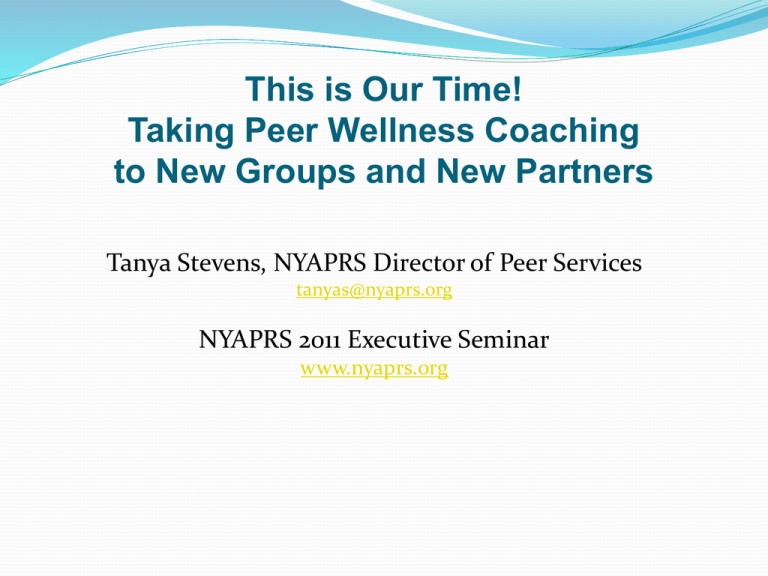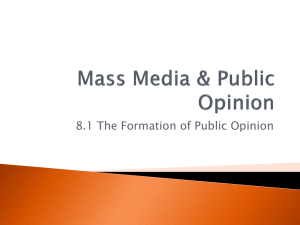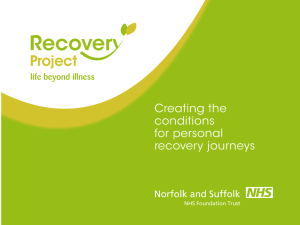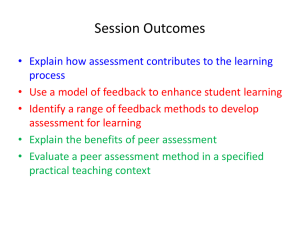This is Our Time - New York Association of Psychiatric Rehabilitation
advertisement

This is Our Time! Taking Peer Wellness Coaching to New Groups and New Partners Tanya Stevens, NYAPRS Director of Peer Services tanyas@nyaprs.org NYAPRS 2011 Executive Seminar www.nyaprs.org Key Elements of Peer Support Sharing, validating and normalizing similar experiences Building empathy, sharing opportunities for connection and knowledge Building honest mutually responsible relationships Based on the intention to change patterns and get unstuck •Full respect for each of our unique processes of change •Willingness to challenge each other Peer Support Models: Helping People and Systems to Get Unstuck Peer Bridging: Alternatives to Long term or ‘Revolving Door’ Use of Inpatient Care Peer Health Care Coaching: Support for Improved Self-managed Health and Recovery Peer Crisis Support and Respite: Alternatives to Chronic Use of Emergency/Inpatient Care Peer Brokered Self Direction: Alternatives to Chronic Community Institutionalization Restoring Lives, Redirecting and Saving $ NYAPRS Peer Bridger Project Background Funded by: New York State Office of Mental Health New York’s Community Reinvestment Act of 1993 Combining Two Top Criteria: Reducing State Hospital Census Promoting Peer Support Development Team: Dr. Edward Knight Dr. Cheryl MacNeil Harvey Rosenthal Chacku Mathai Shery Mead The Peer Bridger Lens “We support each other to get out of the hospital, stay out of the hospital and get the hospital out of us.” NYAPRS Peer Bridger Model Basic Elements Involvement in Mutual Support Meetings in the Hospital and in the Community Developing a Mutually Responsible Peer Relationship Strengthening/Modeling Community Adjustment, Wellness Self-Management and Relapse Prevention/Crisis Management Skills Connecting with Natural and Service-Based Supports and Community Resources Infusing Recovery And Cultural Competence In Hospital And Community Service Settings NYAPRS Peer Support Core Values Honest, direct communication Power sharing and mutuality Building hope and faith Empathy and mutuality Personal responsibility and accountability Valuing and creating community Not using “symptoms” or “illness” as a reason to not meet each other’s needs Learning to work through conflict Being accountable to the relationship Understanding trauma is central NYAPRS Peer Bridger Project Services Skill teaching Social and emotional support Recreation and companionship Development of self-advocacy Mutual peer support Participation at weekly peer support meetings Development of wellness selfmanagement WRAP plans Discovering community (community guides) NYAPRS Peer Bridger Project Reframing Crisis WRAP and Wellness Self-Management Tools Forming Communities of Support Dealing with “Big Feelings” Keeping Your Power When Things Break Down NYAPRS Peer Bridger Project 2010 Data Numbers of Matches Total # of people referred to the project 368 # of people in matches 339 # of people referred from the hospitals 129 # of people who self-referred 239 # of new matches since 1/1/09 312 Additional Data for 2010 Number of Transitions Total # of people released from state psychiatric centers 205 # of people who left psych centers who have not returned for three months or more 199 # of people who transitioned from on-grounds residences 138 # of people who transitioned from inpatient to on-grounds residences or independent living 186 Total # of people who were discharged 320 # of people who were assessed to be discharge ready and who were waiting for community housing 123 Reducing Re-Hospitalization In 2008, the Peer Bridger Project worked with 251 individuals and 190 of those consented to the release of their hospitalization data. After a preliminary review of this data, approximately 136 of these individuals were not re-hospitalized in the state psychiatric centers in 2008. That means that approximately 72% percent of the people we worked with were able to stay out of the hospital for the following year. 2007 Data on Peer Support Meetings and Staff Trainings Peer Support Meetings held in State PCs 33 Peer Support Meetings held in the community 31 Average # of people attending each meeting Total # of people served in meetings Plus: 148 hospital and community trainings conducted by the Peer Support Specialists 13 1,300 wellness matters On average, individuals with a psychiatric diagnosis die 25 years earlier than people in the general population. Sixty percent of premature deaths can be attributed to medical conditions that are frequently caused by or worsened by controllable lifestyle factors such as: • poor diet and nutrition • smoking • substance abuse • limited physical activity • difficulty accessing consistent medical care Morbidity and Mortality in People with Serious Mental Illness NASMHPD October 2006 14 The Promise of Peer Health Care Coaching: NYAPRS Proposal to OptumHealth CDIP Most healthcare systems don’t appreciate the crucial importance of relationship, of fostering hope for change, of being available before and during crises: they often passively wait in vain for people whose struggles, whose lack of financial and transportation resources and whose lack of hope and connection make them appear to be ‘non compliant no shows.’ We know…we are those ‘high cost high needs’ people with medical and behavioral health conditions. Building on our Peer Bridger experience, NYAPRS Peer Wellness Coaches can help bring hope and proactive, personalized, mobile ‘real time’ relationship-based help. 15 A Peer Wellness Coach is Someone Who Shares experiences and hope Uses communication skills Uses motivational questions Assists with challenging perceptions Assists with inner strength building Assists with problem solving Asks permission before giving a suggestion Assists with goal setting Assists with strategic planning 16 Peer Support in OptumHealth’s Chronic Illness Demonstration Project in NY NYAPRS Peer Health Care Coaching Assist With Locating And Enrolling Consumers Provide Individual Health Coaching and Support Provide Health Focused Peer Support Groups Link Individuals With Local Mental Health Supports Assist With Relapse Prevention Activities, Actively Participate In Enrollee Treatment Planning PEOPLe, Inc Peer And Staff Training On Recovery And Relapse Prevention Possible Establishment Of Crisis Respite Residence CIDP Peer Wellness Coaching Activities • Using provided contact information, seek out identified Medicaid recipients to explain program, encourage them to enroll in program, and complete initial enrollment forms • Engage enrolled individuals to form trust-based relationships that foster hope for positive change and personal empowerment • Examine lifestyle factors that impact health and wellness with enrolled individuals • Utilize tools with enrolled individuals to discuss and plan for changing to behaviors that will lead to improved health selfmanagement • Help enrolled individuals identify and engage with a range of community-based supports • Serve on Project Management Subcommittees 18 Peer Wellness Coaching Basics Motivational Dialogues toward Healthy Living •Asking helpful questions •Building self-confidence •Connecting with personal goals •Focusing on what’s important Realistic Possibilities •People may not be ready for change •It may take numerous attempts to change a lifestyle behavior •Lack of personal motivation hinders someone’s willingness to change •Minimal patience “Wanting what you want, when you want it” 19 Critical CDIP Role Our Queens peer wellness coaches helped find, engage and enroll over 1/3 of identified beneficiaries. They helped OptumHealth staff successfully connect with numerous community agencies that proved helpful in finding or serving this group. Our coaches’ inclusion in OptumHealth’s weekly team case rounds “gives the team the opportunity to learn from our peer partners, and hear an additional viewpoint on how to best manage the case being presented. In addition it is a great opportunity to get additional case referrals to peer support.” 20 Moving Forward: AmeriChoice/OptumHealth Peer Bridger Initiative Contract to work with 200+ identified NYC/LI Medicaid Managed Care beneficiaries who have had multiple re-hospitalizations and have not engaged with outpatient services (‘high needs high cost’) Goals are to reduce re-hospitalization rate by 40% and to improve ‘community tenure’ by 15% Similar objectives to CDIP: increase hope, support and self care, increase connection to healthcare, reduce avoidable ER and inpatient use 21 Moving Forward: AmeriChoice/OptumHealth Peer Bridger Initiative 6 trained NYAPRS Peer Bridgers/Wellness Coaches with TRAC phones and cars, poised for prompt engagement and outreach efforts and active, ongoing support, real time crisis assistance. Complementing individual relationships and efforts with peer support meetings in or around high use clinics. 22 This is Our Time National and state healthcare systems are focused on improving care via greater focus on wellness and prevention, especially for ‘high needs high cost’ people with complex medical and mental health conditions. Peer bridgers/wellness coaches provide a critical new resource: appealing, active, empathetic, engaging, mobile, community based, positive support skilled at helping people to gain the hope to get better via improved self care and improved connection to appropriate healthcare….before the next crisis. 23 Peer Bridger Qualifications Peer Bridgers are individuals who have demonstrated that they are successfully managing their own recovery Peer Bridgers are trained facilitators in Mary Ellen Copeland’s Wellness Recovery Action Program Peer Bridgers have completed the CUNY credentialing program on Peer Wellness coaching Peer Bridgers are trained in Shery Mead’s model of Intentional Peer Support




